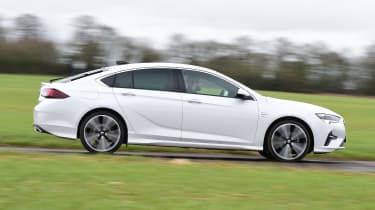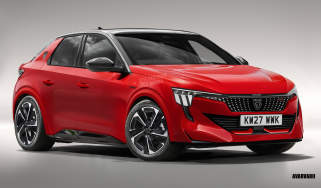Vauxhall Insignia (2017-2022) review - Engines, performance and drive
The Vauxhall Insignia is good to drive, with a compliant ride and tidy handling

Vauxhall has worked hard on the Insignia to improve its ride and handling over the old model, and it really has paid off. It’s smooth at low speed, and while you’ll notice bigger bumps when moving a bit faster, the compliant suspension set-up keeps things impressively composed overall.
Experience the FlexRide adaptive dampers fitted to the petrol models, and you'll notice the Insignia's ability is broadened even further. In Tour mode the chassis set-up is soft and compliant, absorbing corrugations over bad surfaces with a smooth edge, even on cars with wheels of 18 inches and more. Switch to Sport and you don’t lose too much of this welcome suppleness from the set-up, because the suspension’s fluidity remains. You get a little more body control for faster driving on country roads, but the Insignia is at its best in the most comfort-orientated setting.
Even on the motorway, road and wind noise isn’t intrusive - it’s great at long distance travel, in fact, and will suit company car buyers who do a lot of miles. However, we found the 120bhp 1.5-litre diesel a little underpowered and unrefined - noisy at startup and, in manual form, you have to work the six-speed 'box tin order to get up to motorway speeds.
More reviews
Car group tests
In-depth reviews
Road tests
Used car tests
That said, the Insignia is good fun on a twisty road, with tidy and enjoyable handling. The steering is well weighted and there’s enough feel to place the car on the road in confidence. There’s a bit of body roll, but weight savings over the previous model mean it’s more agile than you’d expect for a car of its size.
While it’s more fun than a Mondeo or Passat, the Skoda Superb is better in other ways, including the slicker manual gear change and more comfortable driving position.
Engines, 0-60 acceleration and top speed
The 120bhp diesel version is possibly one to avoid as it's particularly slow - only capable of 0-62mph in 10.7 seconds as a manual and 11.5 seconds in auto form. There's not much going on below 2,500rpm, while it seems to run out of puff above 3,500rpm, and it's every bit as lethargic as the numbers suggest. The 172bhp version is a better bet with the power boost and extra 81Nm of torque helping to improve the sprint time to a more respectable 8.2 seconds.
You'll see faster acceleration times if you choose either of the petrol models: the 197bhp car manages 7.2 seconds and a 146mph maximum, although the (now discontinued) 227bhp variant is only two tenths quicker and adds just 1mph onto the top speed.









